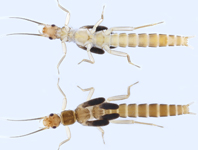Abstract
The genus Haplaxius is a large taxon of cixiid planthoppers that is of economic importance due to the ability of Haplaxius crudus to transmit lethal yellowing in coconut palms. Haplaxius dougwalshi sp. n. is established as a new taxon of Cixiidae in the tribe Oecleini collected from native palms in lowland tropical rainforest in Costa Rica. Placement in the genus Haplaxius is supported both by molecular evidence based on the COI and 18S genes as well as by morphological characters. This novel taxon was discovered during survey work in Costa Rica to look for phytoplasmas and document planthopper diversity on palms. Furthermore, Haplaxius skarphion was also collected from coconut palms during survey work and is reported for the first time in Costa Rica.
References
Bahder, B.W., Bartlett, C.R., Barrantes, E.A.B., Echavarria, M.A.Z., Humphries, A.R., Helmick, E.E., Goss, E.M. & Ascunce, M.S. (2019a) A new genus and species of cixiid planthopper (Hemiptera: Auchenorrhyncha: Fulgoroidea) from the Reserva Privada el Silencio de Los Angeles Cloud Forest in Costa Rica. Zootaxa, 4701 (1), 065–081.
https://doi.org/10.11646/zootaxa.4701.1.5
Bahder, B.W., Bartlett, C.R., Barrantes, E.A.B., Echavarria, M.A.Z., Humphries, A.R., Helmick, E.E., Ascunce, M.S. & Goss, E.M. (2019b) A new species of Omolicna (Hemiptera: Auchenorrhyncha: Fulgoroidea: Derbidae) from coconut palm in Costa Rica and new country records for Omolicna brunnea and Omolicna triata. Zootaxa, 4577 (3), 501–514.
https://doi.org/10.11646/zootaxa.4577.3.5
Bartlett, C.R., O’Brien, L.B. & Wilson, S.W. (2014) A review of the planthoppers (Hemiptera: Fulgoroidea) of the United States. Memoirs of the American Entomological Society, 50, 1–287.
Boudon-Padieu, E. (2003) The situation of grapevine yellows and current research directions: distribution, diversity, vectors, diffusion and control. In Extended abstracts of the 14th meeting of ICVG, Locorotondo, 2003, 46–53.
Bourgoin, T. & Huang, J. (1990) Morphologie comparé des genitalia mâles des Trypetimorphini et remarques phylogénétiques (Hemiptera: Fulgoromorpha: Tropiduchidae). Annales de la Société entomologique de France, 26, 555–564.
Bourgoin, T., Wang, R.R., Ache, M., Hoch, H., Soulier-Perkins, A., Stroinski, A., Yap, S. & Szwedo, J. (2015) From micropterism to hyperpterism: recognition strategy and standardized homology-driven terminology of the forewing venation patterns in planthoppers (Hemiptera: Fulgoromorpha). Zoomorphology, 134 (1), 63–77.
https://doi.org/10.1007/s00435-014-0243-6
Bourgoin, T. (2020) FLOW (Fulgoromorpha Lists on The Web): a world knowledge base dedicated to Fulgoromorpha. Version 8. Updated March 13th, 2020, Available from: https://hemiptera-databases.org/flow/ (accessed 23 March 2020)
Fowler, W.W. 1904. Order Rhynchota. Suborder Hemiptera-Homoptera. (Continued). Biologia Centrali-Americana, 1, 85–124.
Howard, F.W. & Thomas D.L. (1980) Transmission of palm lethal decline to Veitchia merrillii by a planthopper Myndus crudus. Journal of Economic Entomology, 73 (5), 715–717.
https://doi.org/10.1093/jee/73.5.715
Julia, J.F., Dollet, M., Randles, J. & Calvez, C. (1985) Foliar decay of coconut by Myndus taffini (FDMT): new results. Oléagineux, 40 (1), 19–27.
Kramer, J.P. (1979) Taxonomic study of the planthopper genus Myndus in the Americas (Homoptera: Fulgoroidea: Cixiidae). Transactions of the American Entomological Society, 105 (3), 301–389.
Kumar, S., Stecher, G. & Tamura, K. (2016) MEGA7: Molecular Evolutionary Genetics Analysis version 7.0 for bigger datasets. Molecular Biology and Evolution, 33, 1870–1874.
https://doi.org/10.1093/molbev/msw054
Muir, F.A.G. (1922) New Malayan Cixiidae (Homoptera). Philippine Journal of Science, 20, 111–119.
Myrie, W., Helmick, E.E., Bartlett, C.R., Bertaccini, A. & Bahder, B.W. (2019) A new species of planthopper belonging to the genus Oecleus Stål, 1862 (Hemiptera: Fulgoroidea: Cixiidae) from coconut palm (Cocos nucifera L) in Jamaica. Zootaxa, 4712 (1), 127–137.
https://doi.org/10.11646/zootaxa.4712.1.9
Simon, C., Frati, F., Beckenbach, A., Crespi, B., Liu, H. & Flook, P. (1994) Evolution, weighting, and phylogenetic utility of mitochondrial gene sequences and a compilation of conserved polymerase chain reaction primers. Annals of the Entomological Society of America, 87 (6), 651–701.
https://doi.org/10.1093/aesa/87.6.651
Spinola, M. (1839) Essai sur les Fulgorelles, sous-tribu de la tribu des Cicadaires, ordre des Rhyngotes. Annales de la Société Entomologique de France, 8, 133–337.
Stål, C. (1862) Novae vel minus cognitae Homopterorum formae et species. Berliner Entomologische Zeitschrift, 6, 303–315.
https://doi.org/10.1002/mmnd.47918620303
Wefels, E., Morin, J.P. & Randles, J.W. (2015) Molecular evidence for a persistent-circulative association between coconut foliar decay virus and its vector Myndus taffini. Australasion Plant Pathology, 44 (3), 283–288.


